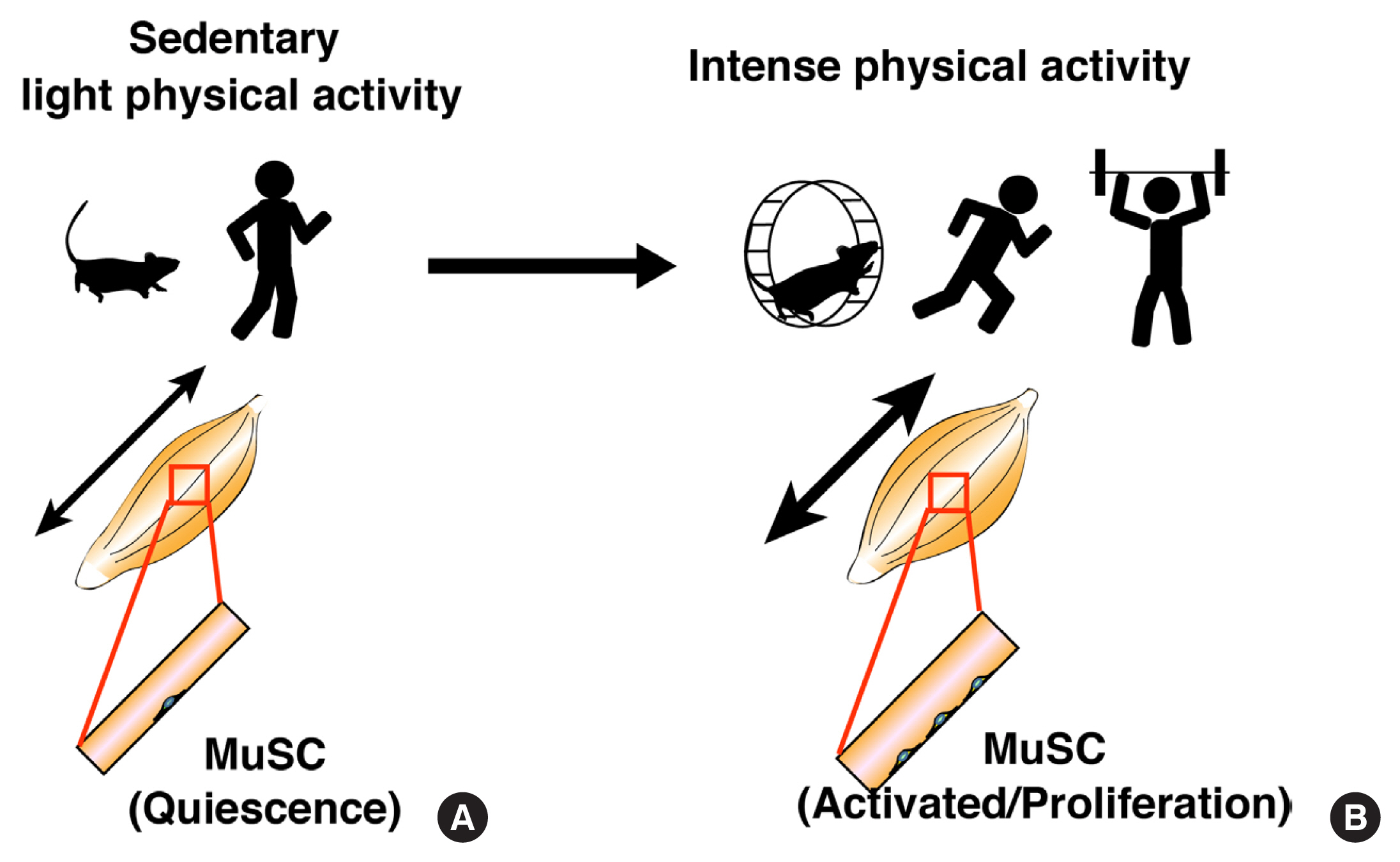Search
- Page Path
- HOME > Search
Review Article
- Diabetes, Obesity and Metabolism
- Exercise/Resistance Training and Muscle Stem Cells
- So-ichiro Fukada, Ayasa Nakamura
- Endocrinol Metab. 2021;36(4):737-744. Published online August 10, 2021
- DOI: https://doi.org/10.3803/EnM.2021.401

- 5,252 View
- 260 Download
- 6 Web of Science
- 7 Crossref
-
 Abstract
Abstract
 PDF
PDF PubReader
PubReader  ePub
ePub - Skeletal muscle has attracted attention as endocrine organ, because exercise-dependent cytokines called myokines/exerkines are released from skeletal muscle and are involved in systemic functions. While, local mechanical loading to skeletal muscle by exercise or resistance training alters myofiber type and size and myonuclear number. Skeletal muscle-resident stem cells, known as muscle satellite cells (MuSCs), are responsible for the increased number of myonuclei. Under steady conditions, MuSCs are maintained in a mitotically quiescent state but exit from that state and start to proliferate in response to high physical activity. Alterations in MuSC behavior occur when myofibers are damaged, but the lethal damage to myofibers does not seem to evoke mechanical loading-dependent MuSC activation and proliferation. Given that MuSCs proliferate without damage, it is unclear how the different behaviors of MuSCs are controlled by different physical activities. Recent studies demonstrated that myonuclear number reflects the size of myofibers; hence, it is crucial to know the properties of MuSCs and the mechanism of myonuclear accretion by MuSCs. In addition, the elucidation of mechanical load-dependent changes in muscle resident cells, including MuSCs, will be necessary for the discovery of new myokines/exerkines and understating skeletal muscle diseases.
-
Citations
Citations to this article as recorded by- Control of muscle satellite cell function by specific exercise‐induced cytokines and their applications in muscle maintenance
Qian Guo, Qing Luo, Guanbin Song
Journal of Cachexia, Sarcopenia and Muscle.2024; 15(2): 466. CrossRef - Resistance exercise preconditioning prevents disuse muscle atrophy by inhibiting apoptosis and protein degradation via SESN2 in C57BL/6J mice
Yating Huang, Chenxin Jiang, Xiuru Li, Sujuan Liu, Yanmei Niu, Li Fu
Biochimica et Biophysica Acta (BBA) - Molecular Basis of Disease.2024; 1870(4): 167111. CrossRef - Anthropometric, muscle and serum myokine levels effects of physical exercise with an online platform in female patients with obesity
David Primo, Olatz Izaola, Juan Jose Lopez Gomez, Daniel de Luis
Endocrinología, Diabetes y Nutrición.2023; 70(7): 484. CrossRef - Anthropometric, muscle and serum myokine levels effects of physical exercise with an online platform in female patients with obesity
David Primo, Olatz Izaola, Juan Jose Lopez Gomez, Daniel de Luis
Endocrinología, Diabetes y Nutrición (English ed.).2023; 70(7): 484. CrossRef - The muscle stem cell niche at a glance
Margaret Hung, Hsiao-Fan Lo, Grace E. L. Jones, Robert S. Krauss
Journal of Cell Science.2023;[Epub] CrossRef - Exercise Therapy for People With Sarcopenic Obesity: Myokines and Adipokines as Effective Actors
Hamed Alizadeh Pahlavani
Frontiers in Endocrinology.2022;[Epub] CrossRef - Molecular mechanisms of exercise contributing to tissue regeneration
Jibao Chen, Ren Zhou, Ye Feng, Lin Cheng
Signal Transduction and Targeted Therapy.2022;[Epub] CrossRef
- Control of muscle satellite cell function by specific exercise‐induced cytokines and their applications in muscle maintenance


 KES
KES

 First
First Prev
Prev



